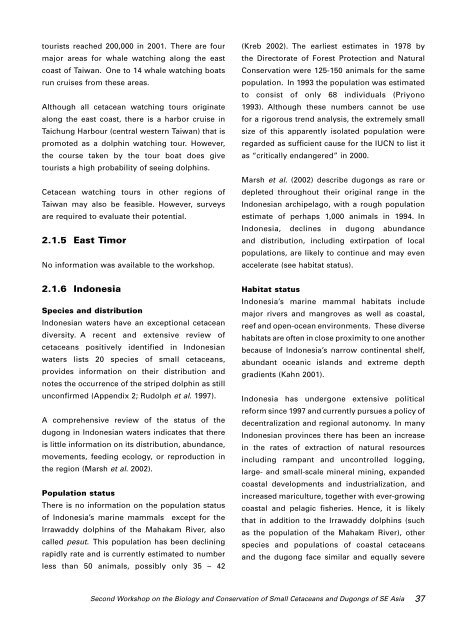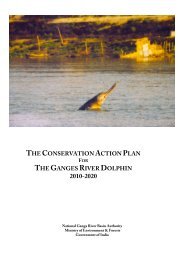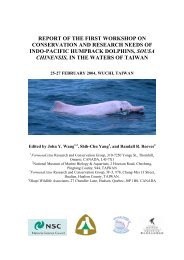Report of the Second Workshop on The Biology and Conservation of ...
Report of the Second Workshop on The Biology and Conservation of ...
Report of the Second Workshop on The Biology and Conservation of ...
Create successful ePaper yourself
Turn your PDF publications into a flip-book with our unique Google optimized e-Paper software.
tourists reached 200,000 in 2001. <strong>The</strong>re are fourmajor areas for whale watching al<strong>on</strong>g <str<strong>on</strong>g>the</str<strong>on</strong>g> eastcoast <str<strong>on</strong>g>of</str<strong>on</strong>g> Taiwan. One to 14 whale watching boatsrun cruises from <str<strong>on</strong>g>the</str<strong>on</strong>g>se areas.Although all cetacean watching tours originateal<strong>on</strong>g <str<strong>on</strong>g>the</str<strong>on</strong>g> east coast, <str<strong>on</strong>g>the</str<strong>on</strong>g>re is a harbor cruise inTaichung Harbour (central western Taiwan) that ispromoted as a dolphin watching tour. However,<str<strong>on</strong>g>the</str<strong>on</strong>g> course taken by <str<strong>on</strong>g>the</str<strong>on</strong>g> tour boat does givetourists a high probability <str<strong>on</strong>g>of</str<strong>on</strong>g> seeing dolphins.Cetacean watching tours in o<str<strong>on</strong>g>the</str<strong>on</strong>g>r regi<strong>on</strong>s <str<strong>on</strong>g>of</str<strong>on</strong>g>Taiwan may also be feasible. However, surveysare required to evaluate <str<strong>on</strong>g>the</str<strong>on</strong>g>ir potential.2.1.5 East TimorNo informati<strong>on</strong> was available to <str<strong>on</strong>g>the</str<strong>on</strong>g> workshop.(Kreb 2002). <strong>The</strong> earliest estimates in 1978 by<str<strong>on</strong>g>the</str<strong>on</strong>g> Directorate <str<strong>on</strong>g>of</str<strong>on</strong>g> Forest Protecti<strong>on</strong> <strong>and</strong> NaturalC<strong>on</strong>servati<strong>on</strong> were 125-150 animals for <str<strong>on</strong>g>the</str<strong>on</strong>g> samepopulati<strong>on</strong>. In 1993 <str<strong>on</strong>g>the</str<strong>on</strong>g> populati<strong>on</strong> was estimatedto c<strong>on</strong>sist <str<strong>on</strong>g>of</str<strong>on</strong>g> <strong>on</strong>ly 68 individuals (Priy<strong>on</strong>o1993). Although <str<strong>on</strong>g>the</str<strong>on</strong>g>se numbers cannot be usefor a rigorous trend analysis, <str<strong>on</strong>g>the</str<strong>on</strong>g> extremely smallsize <str<strong>on</strong>g>of</str<strong>on</strong>g> this apparently isolated populati<strong>on</strong> wereregarded as sufficient cause for <str<strong>on</strong>g>the</str<strong>on</strong>g> IUCN to list itas “critically endangered” in 2000.Marsh et al. (2002) describe dug<strong>on</strong>gs as rare ordepleted throughout <str<strong>on</strong>g>the</str<strong>on</strong>g>ir original range in <str<strong>on</strong>g>the</str<strong>on</strong>g>Ind<strong>on</strong>esian archipelago, with a rough populati<strong>on</strong>estimate <str<strong>on</strong>g>of</str<strong>on</strong>g> perhaps 1,000 animals in 1994. InInd<strong>on</strong>esia, declines in dug<strong>on</strong>g abundance<strong>and</strong> distributi<strong>on</strong>, including extirpati<strong>on</strong> <str<strong>on</strong>g>of</str<strong>on</strong>g> localpopulati<strong>on</strong>s, are likely to c<strong>on</strong>tinue <strong>and</strong> may evenaccelerate (see habitat status).2.1.6 Ind<strong>on</strong>esiaSpecies <strong>and</strong> distributi<strong>on</strong>Ind<strong>on</strong>esian waters have an excepti<strong>on</strong>al cetace<strong>and</strong>iversity. A recent <strong>and</strong> extensive review <str<strong>on</strong>g>of</str<strong>on</strong>g>cetaceans positively identified in Ind<strong>on</strong>esianwaters lists 20 species <str<strong>on</strong>g>of</str<strong>on</strong>g> small cetaceans,provides informati<strong>on</strong> <strong>on</strong> <str<strong>on</strong>g>the</str<strong>on</strong>g>ir distributi<strong>on</strong> <strong>and</strong>notes <str<strong>on</strong>g>the</str<strong>on</strong>g> occurrence <str<strong>on</strong>g>of</str<strong>on</strong>g> <str<strong>on</strong>g>the</str<strong>on</strong>g> striped dolphin as stillunc<strong>on</strong>firmed (Appendix 2; Rudolph et al. 1997).A comprehensive review <str<strong>on</strong>g>of</str<strong>on</strong>g> <str<strong>on</strong>g>the</str<strong>on</strong>g> status <str<strong>on</strong>g>of</str<strong>on</strong>g> <str<strong>on</strong>g>the</str<strong>on</strong>g>dug<strong>on</strong>g in Ind<strong>on</strong>esian waters indicates that <str<strong>on</strong>g>the</str<strong>on</strong>g>reis little informati<strong>on</strong> <strong>on</strong> its distributi<strong>on</strong>, abundance,movements, feeding ecology, or reproducti<strong>on</strong> in<str<strong>on</strong>g>the</str<strong>on</strong>g> regi<strong>on</strong> (Marsh et al. 2002).Populati<strong>on</strong> status<strong>The</strong>re is no informati<strong>on</strong> <strong>on</strong> <str<strong>on</strong>g>the</str<strong>on</strong>g> populati<strong>on</strong> status<str<strong>on</strong>g>of</str<strong>on</strong>g> Ind<strong>on</strong>esia’s marine mammals except for <str<strong>on</strong>g>the</str<strong>on</strong>g>Irrawaddy dolphins <str<strong>on</strong>g>of</str<strong>on</strong>g> <str<strong>on</strong>g>the</str<strong>on</strong>g> Mahakam River, alsocalled pesut. This populati<strong>on</strong> has been decliningrapidly rate <strong>and</strong> is currently estimated to numberless than 50 animals, possibly <strong>on</strong>ly 35 – 42Habitat statusInd<strong>on</strong>esia’s marine mammal habitats includemajor rivers <strong>and</strong> mangroves as well as coastal,reef <strong>and</strong> open-ocean envir<strong>on</strong>ments. <strong>The</strong>se diversehabitats are <str<strong>on</strong>g>of</str<strong>on</strong>g>ten in close proximity to <strong>on</strong>e ano<str<strong>on</strong>g>the</str<strong>on</strong>g>rbecause <str<strong>on</strong>g>of</str<strong>on</strong>g> Ind<strong>on</strong>esia’s narrow c<strong>on</strong>tinental shelf,abundant oceanic isl<strong>and</strong>s <strong>and</strong> extreme depthgradients (Kahn 2001).Ind<strong>on</strong>esia has underg<strong>on</strong>e extensive politicalreform since 1997 <strong>and</strong> currently pursues a policy <str<strong>on</strong>g>of</str<strong>on</strong>g>decentralizati<strong>on</strong> <strong>and</strong> regi<strong>on</strong>al aut<strong>on</strong>omy. In manyInd<strong>on</strong>esian provinces <str<strong>on</strong>g>the</str<strong>on</strong>g>re has been an increasein <str<strong>on</strong>g>the</str<strong>on</strong>g> rates <str<strong>on</strong>g>of</str<strong>on</strong>g> extracti<strong>on</strong> <str<strong>on</strong>g>of</str<strong>on</strong>g> natural resourcesincluding rampant <strong>and</strong> unc<strong>on</strong>trolled logging,large- <strong>and</strong> small-scale mineral mining, exp<strong>and</strong>edcoastal developments <strong>and</strong> industrializati<strong>on</strong>, <strong>and</strong>increased mariculture, toge<str<strong>on</strong>g>the</str<strong>on</strong>g>r with ever-growingcoastal <strong>and</strong> pelagic fisheries. Hence, it is likelythat in additi<strong>on</strong> to <str<strong>on</strong>g>the</str<strong>on</strong>g> Irrawaddy dolphins (suchas <str<strong>on</strong>g>the</str<strong>on</strong>g> populati<strong>on</strong> <str<strong>on</strong>g>of</str<strong>on</strong>g> <str<strong>on</strong>g>the</str<strong>on</strong>g> Mahakam River), o<str<strong>on</strong>g>the</str<strong>on</strong>g>rspecies <strong>and</strong> populati<strong>on</strong>s <str<strong>on</strong>g>of</str<strong>on</strong>g> coastal cetaceans<strong>and</strong> <str<strong>on</strong>g>the</str<strong>on</strong>g> dug<strong>on</strong>g face similar <strong>and</strong> equally severe<str<strong>on</strong>g>Sec<strong>on</strong>d</str<strong>on</strong>g> <str<strong>on</strong>g>Workshop</str<strong>on</strong>g> <strong>on</strong> <str<strong>on</strong>g>the</str<strong>on</strong>g> <strong>Biology</strong> <strong>and</strong> C<strong>on</strong>servati<strong>on</strong> <str<strong>on</strong>g>of</str<strong>on</strong>g> Small Cetaceans <strong>and</strong> Dug<strong>on</strong>gs <str<strong>on</strong>g>of</str<strong>on</strong>g> SE Asia 37





